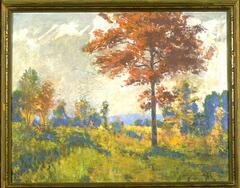28 UMMA Objects
28 UMMA Objects

Dogon (Dogon (culture or style))
Ritual Staff
20th century
Gift of Dr. and Mrs. Irving F. Burton
1975/1.69
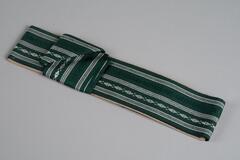
Japanese (Japanese (culture or style))
Tie
20th century
Gift of Howard and Patricia Yamaguchi
2013/2.472
![A corn husk woven basket with wooden shaping dowels. One side of the rectangle is flat while the other end is curved. There are two blue stripes on the inside floor of the basket and green and purple designs on the outside.<br />
<br />
This straw basket (<em>samtaegi</em> ) is woven from dyed straw. The round frame at the back of it is made from bitterwood and the front part from bamboo. Judging from the use of dyed straw, this basket was probably used for drying grain such as soy beans.
<p>[Korean Collection, University of Michigan Museum of Art (2017) p. 277]</p>
A corn husk woven basket with wooden shaping dowels. One side of the rectangle is flat while the other end is curved. There are two blue stripes on the inside floor of the basket and green and purple designs on the outside.<br />
<br />
This straw basket (<em>samtaegi</em> ) is woven from dyed straw. The round frame at the back of it is made from bitterwood and the front part from bamboo. Judging from the use of dyed straw, this basket was probably used for drying grain such as soy beans.
<p>[Korean Collection, University of Michigan Museum of Art (2017) p. 277]</p>](/media/W1siZiIsIjIwMjIvMDkvMjQvZmVlMTZ2YW0yX2RlZmF1bHQuanBnIl0sWyJwIiwidGh1bWIiLCIyNDB4MjAwIl1d?sha=63e41f30e2d00ee4)
Korean (Korean (culture or style))
Winnowing Basket
1850 – 1950
Gift of Ok Ja Chang and the Chang Family
2009/2.49

Indian (Indian (South Asian))
Travelling entertainer
20th century
Gift of Mr. George P. Bickford for the James Marshall Plumer Memorial Collection
1964/2.113
![This type of bowl, with an inverted rim and hollow inside, is known as an <em>okbari</em> or <em>omok-bansanggi</em> (concave tableware). Considering its size, it was probably used for serving steamed rice. The tall foot was made separately before being attached. One line is incised around the outer rim of the bowl, which gently slopes inwards. The nipple-shaped handle is fixed to the top of the lid by a nail. The head of a nail joining the foot to the base of the bowl is visible on the indented base of the foot.
<p>[Korean Collection, University of Michigan Museum of Art (2017), 249]</p>
This type of bowl, with an inverted rim and hollow inside, is known as an <em>okbari</em> or <em>omok-bansanggi</em> (concave tableware). Considering its size, it was probably used for serving steamed rice. The tall foot was made separately before being attached. One line is incised around the outer rim of the bowl, which gently slopes inwards. The nipple-shaped handle is fixed to the top of the lid by a nail. The head of a nail joining the foot to the base of the bowl is visible on the indented base of the foot.
<p>[Korean Collection, University of Michigan Museum of Art (2017), 249]</p>](/media/W1siZiIsIjIwMjIvMDkvMjQvMXltYnU1bTZzOV9kZWZhdWx0LmpwZyJdLFsicCIsInRodW1iIiwiMjQweDIwMCJdXQ?sha=209b642fb884c3d4)
Korean (Korean (culture or style))
Covered Bowl
1900 – 1950
Gift of Bruce and Inta Hasenkamp and Museum purchase made possible by Elder and Mrs. Sang-Yong Nam
2004/1.304A&B
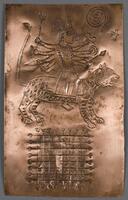
Indian (Indian (South Asian))
Durga Copper Plate
1800 – 1999
Gift of Dr. and Mrs. Leo S. Figiel and Dr. and Mrs. Steven J. Figiel.
1975/2.146
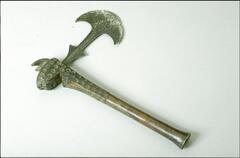
Pende;Chokwe (Pende;Chokwe (culture or style))
Prestige Axe
20th century
Gift of Susan B. and John F. Ullrich
1998/1.52
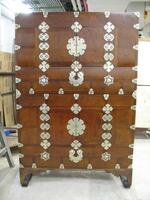
Korean (Korean (culture or style))
Chest (in three pieces)
1850 – 1950
Museum Purchase made possible by the Margaret Watson Parker Art Collection Fund
2009/2.26A-C
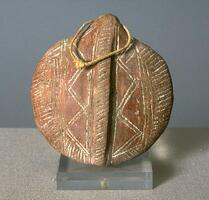
Malian
Ceramic Jewelry Molds (One of eighteen)
1900 – 1932
Gift of Prof. and Mrs. Horace M. Miner
1983/2.211
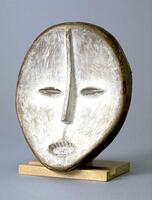
Lega (Lega)
Bwami Society Maskette
1900 – 1975
Gift of the Friends of the Museum of Art in memory of Diana B. Fox
1985/1.151
Loading…
